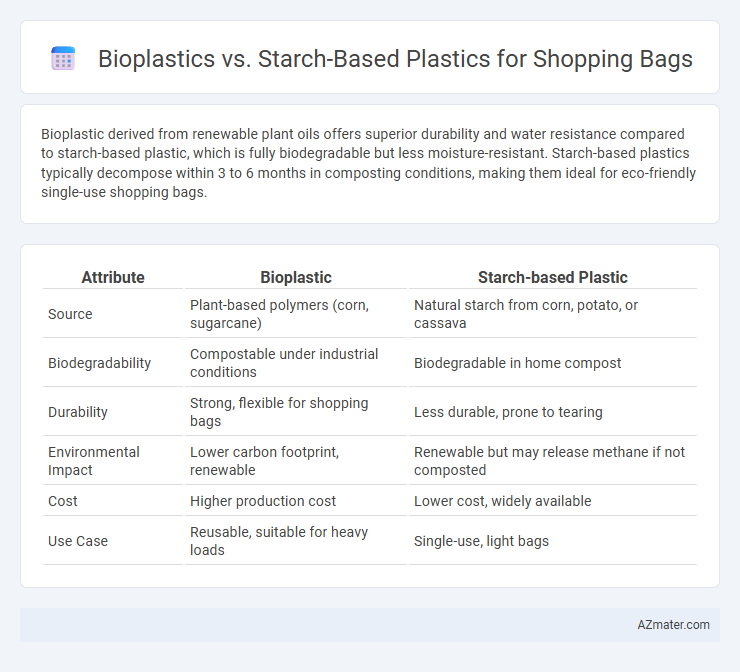Bioplastic derived from renewable plant oils offers superior durability and water resistance compared to starch-based plastic, which is fully biodegradable but less moisture-resistant. Starch-based plastics typically decompose within 3 to 6 months in composting conditions, making them ideal for eco-friendly single-use shopping bags.
Table of Comparison
| Attribute | Bioplastic | Starch-based Plastic |
|---|---|---|
| Source | Plant-based polymers (corn, sugarcane) | Natural starch from corn, potato, or cassava |
| Biodegradability | Compostable under industrial conditions | Biodegradable in home compost |
| Durability | Strong, flexible for shopping bags | Less durable, prone to tearing |
| Environmental Impact | Lower carbon footprint, renewable | Renewable but may release methane if not composted |
| Cost | Higher production cost | Lower cost, widely available |
| Use Case | Reusable, suitable for heavy loads | Single-use, light bags |
Introduction to Bioplastics and Starch-Based Plastics
Bioplastics are derived from renewable biomass sources such as corn, sugarcane, or cellulose, offering a sustainable alternative to traditional petroleum-based plastics by reducing carbon footprint and enhancing biodegradability. Starch-based plastics, a subset of bioplastics, utilize natural starch extracted from crops like maize or potatoes, which provides compostability and reduces plastic pollution when used for shopping bags. The chemical structure of starch allows for easy breakdown by microorganisms, making starch-based plastics a popular choice for environmentally friendly packaging solutions.
Defining Bioplastic and Starch-Based Plastic
Bioplastic refers to biodegradable plastics derived from renewable biomass sources such as vegetable fats, oils, cornstarch, or microbiota, offering an eco-friendly alternative to conventional petroleum-based plastics. Starch-based plastic, a subset of bioplastics, is primarily made from natural starches like corn, potato, or tapioca, which provide a biodegradable matrix useful in shopping bag production. Both materials aim to reduce environmental impact through their renewable origins and enhanced biodegradability, but their composition and degradation processes differ significantly.
Raw Materials and Production Processes
Bioplastic shopping bags are primarily derived from renewable biomass such as corn starch, sugarcane, or cellulose, undergoing polymerization processes to create biopolymers like polylactic acid (PLA) or polyhydroxyalkanoates (PHA). In contrast, starch-based plastics utilize raw materials predominantly composed of native starches extracted from potatoes, corn, or wheat, which are modified through processes like gelatinization and plasticization to form thermoplastic starch (TPS). Bioplastics typically involve more complex chemical synthesis to achieve desired properties, while starch-based plastics rely on physical modification and blending to enhance flexibility and strength for shopping bag applications.
Environmental Impact: Bioplastic vs Starch-Based Plastic
Bioplastic and starch-based plastic both aim to reduce environmental harm compared to traditional plastics, but they differ in biodegradability and resource use. Bioplastics derived from renewable biomass like corn or sugarcane can reduce greenhouse gas emissions but may require specific industrial composting facilities for proper degradation. Starch-based plastics, often fully biodegradable in natural environments, minimize plastic pollution and support soil health but may have limitations in durability and water resistance for shopping bag applications.
Biodegradability and Compostability Comparison
Bioplastic shopping bags derived from renewable biomass such as corn starch or sugarcane offer enhanced biodegradability under industrial composting conditions, breaking down within 90 to 180 days. Starch-based plastics, often blended with synthetic polymers, show varying degrees of compostability and biodegradability dependent on the starch concentration and environmental factors, with higher starch content improving degradation rates. Evaluating shopping bags for environmental impact requires analyzing their certification standards like ASTM D6400 for compostability and ISO 14855 for biodegradability to ensure adherence to sustainable disposal practices.
Mechanical Properties and Performance in Shopping Bags
Bioplastic shopping bags, often derived from polylactic acid (PLA), exhibit higher tensile strength and better elongation at break compared to starch-based plastics, making them more durable under stress and better suited for carrying heavier loads. Starch-based plastic bags, composed primarily of natural polymers like corn starch, tend to have lower mechanical strength and are more brittle, which limits their performance for repeated use and heavy-duty applications. Performance-wise, bioplastic bags typically demonstrate improved tear resistance and flexibility, enhancing user experience during shopping, whereas starch-based bags offer superior biodegradability but compromise on mechanical resilience.
Cost Analysis and Commercial Availability
Bioplastic shopping bags typically cost between $0.10 and $0.25 per bag, reflecting higher production expenses due to the use of renewable polymers like polylactic acid (PLA). Starch-based plastic bags are generally cheaper, averaging around $0.05 to $0.15 per bag, benefiting from abundant and low-cost raw materials such as corn or potato starch. Commercially, bioplastic bags are widely available through specialized eco-friendly suppliers, while starch-based plastics have broader market penetration due to established manufacturing processes and compatibility with existing plastic production lines.
Regulatory Standards and Certifications
Bioplastic shopping bags must comply with ASTM D6400 and EN 13432 standards for compostability, while starch-based plastics often require certification from organizations like BPI or TUV Austria to validate biodegradability claims. Regulatory frameworks such as the European Union's Single-Use Plastics Directive emphasize strict labeling and certification for both bioplastic and starch-based bags to ensure environmental safety and consumer transparency. Compliance with these certifications not only facilitates market acceptance but also promotes sustainable packaging practices aligned with global environmental policies.
Consumer Perception and Market Trends
Consumer perception of bioplastic shopping bags is increasingly positive due to their renewable origins and reduced carbon footprint, while starch-based plastics are favored for their biodegradability and compostability. Market trends indicate a growing demand for bioplastics in retail sectors driven by sustainability commitments and regulatory pressure to reduce single-use plastics. Innovations in starch-based plastic formulations and increasing consumer awareness are accelerating adoption, positioning both materials as key players in the transition to eco-friendly packaging.
Future Prospects for Sustainable Shopping Bags
Bioplastic and starch-based plastic both present promising futures in sustainable shopping bag development due to their renewable origins and biodegradability. Advancements in biopolymer technology are enhancing the durability and cost-efficiency of bioplastics, while starch-based plastics continue to evolve with improved water resistance and compostability. Market trends indicate growing consumer demand and regulatory support for eco-friendly bags, driving innovation toward scalable manufacturing and wider adoption in retail sectors.

Infographic: Bioplastic vs Starch-based Plastic for Shopping Bag
 azmater.com
azmater.com